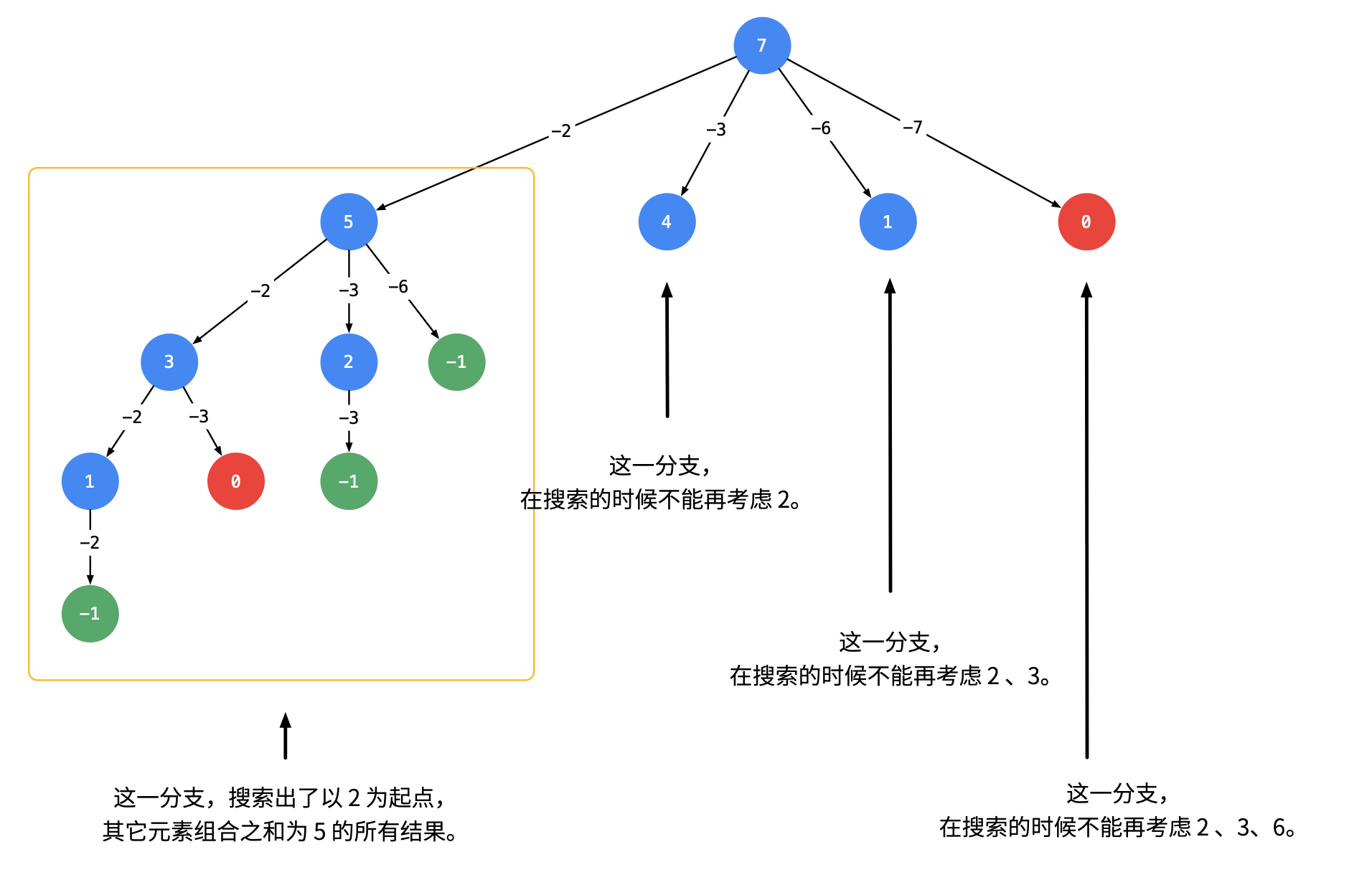关于回溯算法的介绍:回溯其实就存在于递归函数下面,回溯算法是一种暴力搜索法。对于一些问题来说,能够使用暴力搜索法解决就已经很好了,使用一层一层的for循环嵌套,根本都搜索不出来的时候,使用回溯算法就可以搜索出所有解法。
回溯算法能够解决的问题:
组合问题
如:给你一个 无重复元素 的整数数组 candidates 和一个目标整数 target ,找出 candidates 中可以使数字和为目标数 target 的 所有 不同组合 ,并以列表形式返回。你可以按 任意顺序 返回这些组合。
candidates 中的 同一个 数字可以 无限制重复被选取 。如果至少一个数字的被选数量不同,则两种组合是不同的。
切割问题
如:给你一个字符串,问如何切割才能保证所有子字符串都是回文字符串,问有几种切割方式
子集问题
如:求数组{1,2,3,4}的所有子集
排列问题
棋盘问题:N皇后、解数独
回溯算法的模板:
1 | // 回溯递归函数一般没有返回值,参数值比较多 |
组合问题
问题描述:
给你一个无重复元素的整数数组 candidates 和一个目标整数 target ,找出 candidates 中可以使数字和为目标数 target 的所有不同组合 ,并以列表形式返回。你可以按任意顺序返回这些组合。candidates 中的同一个数字可以无限制重复被选取。如果至少一个数字的被选数量不同,则两种组合是不同的。
示例:
1
2输入:candidates = [2,3,6,7], target = 7
输出:[[2,2,3],[7]]思路:
首先,由于不知道给定的整数数组的长度,显然用for循环解决不了这个问题。这时候,就需要用到回溯算法来暴力搜索所有的解法。使用回溯算法,最好要画出它的树形图,此题如下:

说明:
- 以 target = 7 为 根结点 ,创建一个分支的时候做减法 ;
- 每一个箭头表示:从父亲结点的数值减去边上的数值,得到孩子结点的数值。边的值就是题目中给出的 candidate 数组的每个元素的值;
- 减到 0 或者负数的时候停止,即:结点 0 和负数结点成为叶子结点;
- 所有从根结点到结点 0 的路径(只能从上往下,没有回路)就是题目要找的一个结果。
为了避免重复,很显然,前一个分支使用过的元素,后一个分支不能再使用了,如图:

代码如下(进行了一些剪枝操作):
class Solution { 1
2
3
4
5
6
7
8
9
10
11
12
13
14
15
16
17
18
19
20
21
22
23
24
25
26
27
28
29
30
31public List<List<Integer>> combinationSum(int[] candidates, int target) {
List<Integer> path = new ArrayList<>();
List<List<Integer>> solutionSets = new ArrayList<>();
Arrays.sort(candidates);
backtracking(candidates, target, 0, path, solutionSets);
return solutionSets;
}
public void backtracking(int[] candidates, int target, int startIndex, List<Integer> path, List<List<Integer>> solutionSets){
// 回溯算法终止条件
if (target<0){
return;
}
if (target==0){
// 收集结果
solutionSets.add(new ArrayList<>(path));
}
// 单层搜索
for (int i=startIndex; i < candidates.length; i ++){
// 剪枝操作
if(candidates[i] > target){
return;
}
// 对元素进行处理
path.add(candidates[i]);
backtracking(candidates, target-candidates[i], i, path, solutionSets); // 递归
path.remove(path.size()-1); // 回溯
}
}
}